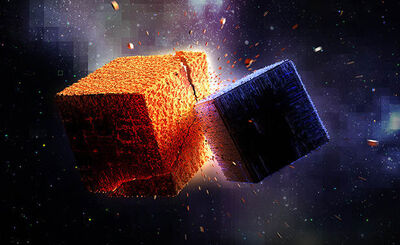
Infinite distance view prototype
Here are some technical details concerning Planets Cube.
Details[ | ]
Here’s a few little details to keep in mind about Planets³:
- The game is still in development; the trailer contains some footages from the current prototype and does not completely reflect the final product.
- An average planet is 8km along each edge, which represents 3.2e+13 blocks. Yes, that’s right: thirty thousand billion blocks: 32 000 000 0000 000! The building potential from just one planet is nearly infinite.
- While on a planet’s surface, the view out into the rest of the universe is nearly endless! This means even from the surface of your own planet, you’ll be able to see moons and other planets in the distance.
- To ensure the game runs with a variety of graphics cards, we have implemented an algorithm of sub-resolution to be able to display a quantity of blocks a individual graphic cards can manage.
- The research is one of the important points of Planets³ development because it is by making this effort that we will be able to improve the visual aspect of the game as well as the player's game experience.
- The planet has a six-pyramid gravity formation, which means that your gravity will always point into the plane of the planet's surface so you can walk off one face of the cubical planet and on to the adjacent one.
Game engine[ | ]

Procedural generation and lighting prototype
Planets³ was based on OGRE 3D engine up to v0.7.7 prototype.
However Cubical Drift realized that the current engine would not allow to improve rendering performance, due to unsatisfied "technical specifications" for massive data rendering[1].
After some research on dozen of different engines, they selected the Unreal Engine, because it was the only one matching all of their constraints[2]:
- Full support for OpenGL3+ and DirectX11, access to shader model 5, and advanced toolset for creating games.
- Ability to easily release the game on different platforms: Windows, Mac, Linux, Consoles.
On top of the engine, they have developed multithreading algorithms to be able to display a massive number of blocks with a large (almost infinite) viewing distance in real time. This allows you to see other planets from the surface (by night and without clouds!).
Technical challenges[ | ]
- Large viewing distance: you will be able to see everything that is happening in the solar system you are in
- Massive amount of blocks to display: a planet is composed of 32 000 000 000 000 of blocks! One tranche of planet is composed of 1 billion of blocks!
- Complex physical engine for blocks made vehicles
- Community Sharing management (to enable players to share their creations)

View distance prototype showing a "view distance" of 12 meters on the left and 40 meters on the right
Technical impossibilities[ | ]
Some ideas seem impossible to achieve with today's computer performances, for instance the in-game collision between two planets: it would engage the calculation of several billion of voxels at the same time.It would also be very difficult to handle remaining voxels, because the gravity acts as a constant vector, rather than a force generated by mass.

